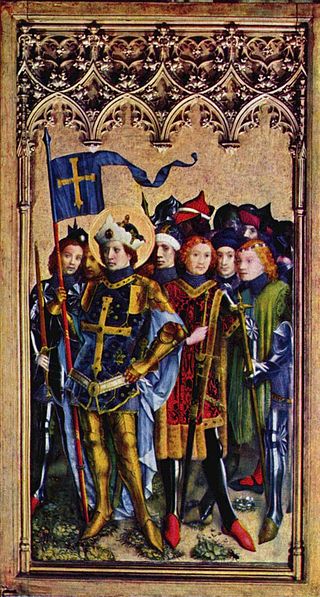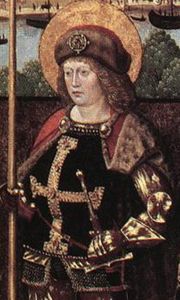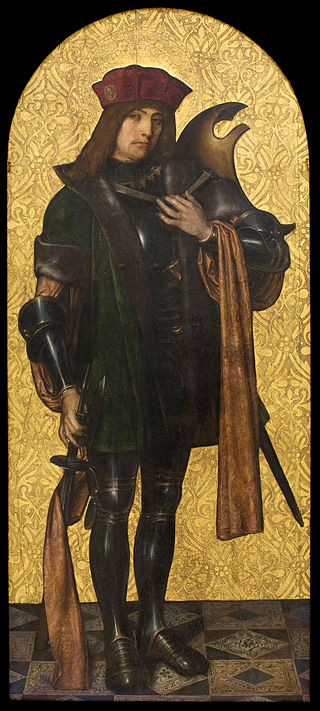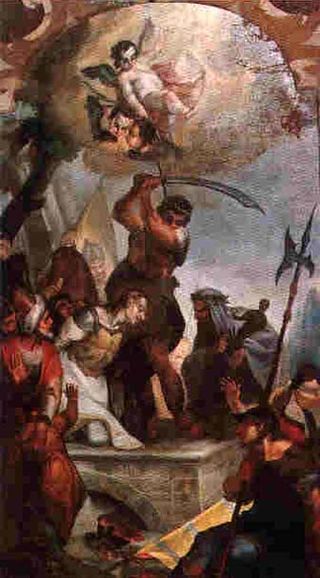
The Theban Legion figures in Christian hagiography as a Roman legion from Egypt —"six thousand six hundred and sixty-six men" — consisting of Christian soldiers who were martyred together in 286, according to the hagiographies of Maurice, the chief among the Legion's saints. Their feast day is held on September 22.

Magnus of Füssen, otherwise Magnoald or Mang, was a missionary saint in southern Germany, also known as the Apostle of the Allgäu. He is believed to have been a contemporary either of Gall or of Boniface and is venerated as the founder of St. Mang's Abbey, Füssen.

Gereon of Cologne, who may have been a soldier, was martyred at Cologne by beheading, probably in the early 4th century.

Castelmagno is a small comune (municipality) in the Province of Cuneo in the Italian region of Piedmont, located about 80 kilometres (50 mi) southwest of Turin and about 25 kilometres (16 mi) west of Cuneo.

Villar San Costanzo is a comune (municipality) in the Province of Cuneo in the Italian region Piedmont, located about 70 kilometres (43 mi) southwest of Turin and about 15 kilometres (9 mi) northwest of Cuneo. As of 31 August 2007, it had a population of 1,474 and an area of 19.5 square kilometres (7.5 sq mi).

Candidus was a commander of the Theban Legion. The Theban Legion was composed of Christians from Upper Egypt. He is venerated as a Christian saint and martyr.
Carpophorus, Exanthus, Cassius, Severinus, Secundus and Licinius were Christian soldiers who, according to tradition, were martyred at Como during the reign of Maximian.

Solutor, along with Octavius and Adventor, is patron saint of Turin.

Alexander of Bergamo is the patron saint of Bergamo, as well as Capriate San Gervasio and Cervignano d'Adda. Alexander may have been a Roman soldier or resident of Bergamo who was tortured and killed for not renouncing his Christian faith. Details of his life are uncertain, but subsequent Christian stories consider him a centurion of the Theban Legion commanded by Maurice.

Fidelis of Como was an Italian soldier-saint, according to Christian tradition.
Saints Felinus and Gratian(us) (sometimes Gratinian(us)) (d. 250 AD) are venerated as martyrs by the Catholic and Eastern Orthodox churches. They are patron saints of Arona, near Milan, where their relics were enshrined.

Defendens of Thebes is venerated as a martyr by the Catholic Church. Venerated as a soldier-saint, Defendens was, according to Christian tradition, a member of the Theban Legion, and thus martyred at Agaunum.

Chiaffredo is venerated as the patron saint of Saluzzo, Italy. Tradition considers him a member of the Theban Legion, but instead of being martyred with this legion at Agaunum, he escaped to Piedmont and was martyred there.

Saint Antoninus of Piacenza is a patron saint of Piacenza in Italy. He is venerated as a saint and martyr in the Roman Catholic Church, with a feast day of 30 September.

San Vincenzo Martire di Craco is a minor saint of the Roman Catholic Church. He is remembered in devotions by the people of Craco in the province of Matera, the Basilicata Region, Italy along with immigrants and their descendants from that town who settled in North America. San Vincenzo Martire di Craco's feast day is celebrated on the fourth Sunday of October in Craco, Italy and Manhattan, New York.

Saint Magnus of Anagni, also known as Magnus of Trani or Magnus of Fabrateria Vetus, is venerated as the patron saint of Anagni.

Constantius is venerated as a member of the legendary Theban Legion. Similar to the cults of Chiaffredo at Crissolo, Bessus at Val Soana, Tegulus at Ivrea, Magnus at Castelmagno, and Dalmatius at Borgo San Dalmazzo, the cult of Constantius was linked with that of the Theban Legion to lend antiquity to a local saint about whom nothing was really known.
Tegulus is venerated as a member of the legendary Theban Legion, whose members were led by Maurice in the 3rd century. The center of Tegulus' cult is at Ivrea. Veneration of Tegulus actually arose at the end of the 10th century, when during the episcopate of Warmondus (Varmondo), the Tegulus's relics were discovered in a sepulcher situated a short distance away from Ivrea. The relics were translated to the cathedral of Ivrea within the city walls, and placed in the chapel of San Giacomo. The relics were later translated, with those of Bessus, to the chapel of Santissimo Sacramento.

Bessus, sometimes Besse, is venerated as a member of the legendary Theban Legion, whose members were led by Maurice and were martyred for their Christian faith in the 3rd century. Except for the cult of Saint Maurice, veneration for Bessus enjoyed a wider popularity than those associated with other saints of the Theban Legion and remains popular today. According to tradition, Constantius survived the decimation of his legion and fled to valleys of Aosta and Cogne. He then dedicated himself to converting the people in this area to Christianity.

Giovanni Battista Arnaud was an Italian painter of frescoes. He mastered as well, the chiaroscuro technique. His work can be found in many churches, palaces and public buildings in different regions of the north of Italy. As well in some churches of France and England. He is also recognized as a great portraitist.
















